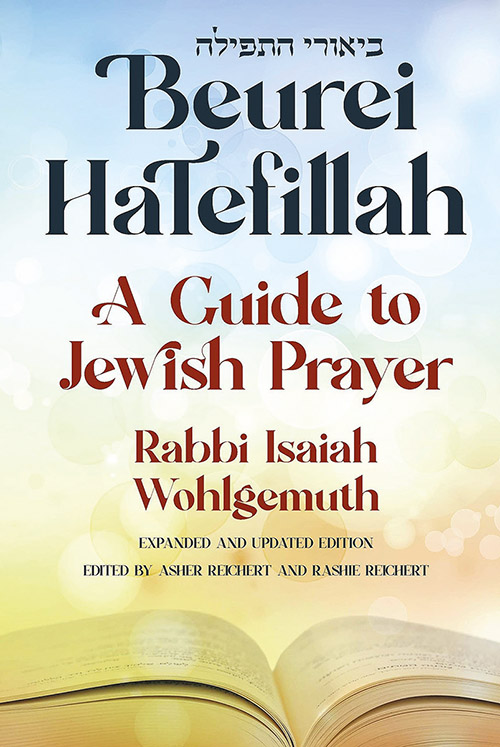
Reviewing: “Beurei HaTefillah: A Guide to Jewish Prayer” by Rabbi Isaiah Wohlgemuth. OU Press. 2021. English. Hardcover. 432 pages. ISBN-13: 978-1602804562.
Before I even get to the content of “Beurei HaTefillah: A Guide to Jewish Prayer” by Rabbi Isaiah Wohlgemuth, two important details must be mentioned. First of all, for avid readers of the Rav, Rav Yosef Dov Soloveitchik, this is a must-have. Rabbi Wohlgemuth taught at Maimonides, the school that the Rav started, and pioneered tefillah education in that school. There are a tremendous amount of insights that were discussed with and shared by the Rav that can be found in the folios herein. So while Rabbi Wohlgemuth has a tremendous amount to offer, one is also afforded ideas related to tefillah from the Rav.
Another detail I believe to be important is how this volume came to be. It is the updated and expanded edition of two previous versions of the insights of Rabbi Wohlgemuth. This effort was spearheaded by students of Rabbi Wohlgemuth, both via the work it took and via the funding of the book. It is beautiful to see his students leading this cause, and speaks volumes to the type of educator he was.
The substance of this book is a product of a course that the author taught for over 30 years at the Maimonides school in Boston. Although it can be utilized as a textbook for other tefillah classes, someone looking to enhance their own prayer service will certainly gain a tremendous amount. Akin to the introduction of Mesillat Yesharim, Rabbi Wohlgemuth in a humble manner shares, “This book is not meant to make new discoveries in the study of the prayers, rather to keep the concentration of the students at a high point.” (Preface)
It is the stated goal of the author to bring thought-provoking questions to the forefront, to allow for engagement with tefillah for the reader or student who may benefit from this. It allows the student to become engaged, and then gain clarity on words that are being uttered multiple times a day.
The author begins this work with a philosophical, historical and halachic frame of reference before even dealing with the details of the text. It is apparent that some sort of introduction is necessary before understanding what we say. Why, when and how do we say what we are about to learn about? He shares the function of prayer, certain laws related to wasteful blessing, necessary intent, times and the direction of the prayers. Additionally, Rabbi Wohlgemuth shares a historical account of the journey to the siddur that we have in front of us, including the Shemoneh Esrei and how our practice of Kabbalat Shabbat developed. He addresses variants found in different siddurim and details emendations made by leading authorities. Here again the practices of the Rav are shared in helping to solve many issues.
The author then moves on to the substance of the tefillah, going in a natural order one should expect: morning berachos, Psukei Dezimra, Shema and its berachos, the Amidah, and then the conclusion of davening. Each element is thoroughly explained and relevant laws are shared. He also elucidates matters concerning Birchat Hamazon, Shabbat and Yom Tov tefilot, Torah readings, Hallel, Selichot, holiday-specific prayers, and even guides us through the Pesach Seder. Within each segment, a person is not left to just follow along and read through insights. Rather, within each section, Rabbi Wohlgemuth asks penetrating questions, provides through and heavily sourced answers, and affords us the opportunity to enhance our tefillah and our relationship with the Almighty.
The author asks basic questions that if the reader hadn’t thought of before, will readily recognize the glaring need to be resolved. For instance, he asks if “vehu rachum” is part of tachanun. Since tachanun is said sitting down, and this prayer is said on Mondays and Thursdays while standing, it is apparent that the two are different. Rabbi Wohlgemuth questions why the specific portions that we say after the morning blessings of the Torah were specifically chosen. He delineates what two categories the birchos hashachar are subsumed under.
An early influence which was a driving force for this passion can be gleaned from a story he shares.
The Torah says: He made Israel travel. Moshe was in a rush, but the Jewish people were … busy picking up the booty of the Egyptian army… I told my congregants: “It seems that the Jews have not changed much in 3,000 years. When we fear our enemies, we turn to God and pray. But the moment we cross the Red Sea, we set out on the road of assimilation and forget God.” (Prologue)
Rabbi Wohlgemuth affords us an opportunity to enhance our experience when we turn to God and understand what we say when we pray to Him. At this time of year, when we focus more on tefillah than at other times, it would greatly benefit a person to check out this book to be able to enhance our High Holidays. It is my hope that this review shares this opportunity with more people who may not have been aware of the treasure found within the ends of this book.
By Eliezer Barany













